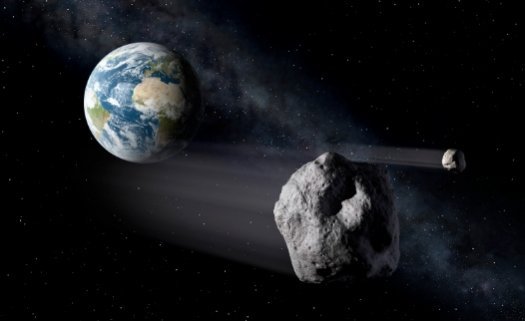Apophis, a 300m-wide asteroid, is making a close pass to the Earth.
Apophis – named after the Egyptian demon of destruction and darkness – has been put on a watch list by scientists.
They have calculated that in 2036 there is a very small chance it could collide with our planet.
However, its current fly-by is at a safe distance of about 14 million km – but this is close enough for astronomers to study the space rock and assess its future risk.
Asteroid 99942 Apophis will not be visible with the naked eye, but space enthusiasts can watch it online via the Slooh space camera’s website.
The large rocky mass was first discovered in 2004. At the time, it raised alarm when scientists calculated that it had a one-in-45 chance of smashing into the Earth in 2029.
Later revisions, lifted this threat; instead on the Friday 13 April 2029, it will make a close pass at a distance of about 30,000km.
However, astronomers say there is still a one-in-200,000 chance that it could strike Earth in 2036.

Professor Alan Fitzsimmons, an astronomer at Queen’s University Belfast, UK, said: “In 2029, it will pass so close to us that Earth’s gravity will change its orbit.
“Most of the potential orbits it will end up on will mean we are safe for the next 100 years. But there is a small region of space – something we call a keyhole – and if it passes through that keyhole in 2029, it will come back and hit us on 13 April in 2036.”
If this happened, it would strike the Earth with 100 times the energy in our largest nuclear bombs, said Prof. Alan Fitzsimmons.
Astronomers are using the current close encounter as an opportunity to study the asteroid, so they can improve their calculations to predict its future path.
Prof. Alan Fitzsimmons said: “While [the asteroid] is relatively close to the Earth, astronomers can ping it with radar. Radar measurements are incredibly accurate: we get the distance to the asteroid very, very precisely, and we can also get its velocity relative to us. And these two things let us pin its orbit down very precisely.”
Researchers are becoming increasingly interested in potentially hazardous asteroids.
So far they have counted more than 9,000 near-Earth asteroids, and they spot another 800 new space rocks on average each year.
Prof. Alan Fitzsimmons said learning more about them was vital.
“At some point, we are going to find an asteroid big enough that it could cause damage at ground level if we let it hit,” he explained.
“So we should find these objects, we should track them, work out where they are going – and if they stand a chance of hitting us, do something about it.”
[youtube KZo-ts2S8VA]
